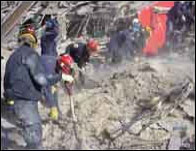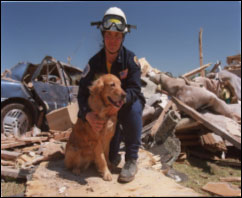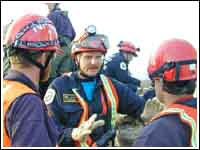|
||||||
| Safety and Health Topics > Emergency Preparedness and Response > Safety and Health Guides > Structural Collapse | ||||||
| Structural Collapse | ||||||
|
||||||
|
Rescue Workers and Emergency Responders may already have experience with entering collapsed structures resulting from (1) construction catastrophes, (2) earthquakes, (3) fire and (4) weather related structural failures. Weather related structural failures typically result from rain/snow accumulations on roofs, hurricanes, tornadoes, landslides and even avalanches. Today, rescue workers and emergency responders also face the possibility of entering a structure that has collapsed following a terrorist attack. Terrorist activity may add additional hazards such as secondary devices, follow-on attack and residual radiological, biological or chemical contamination. Historically, terrorist activities that have resulted in collapsed structures include crashing commercial jets into the World Trade Towers in New York City (September 11, 2001) and vehicular bombs, such as the one used at the Murrah Federal Office Building in Oklahoma City, OK (April 19, 1995). Regardless of the root cause of the structural failure, rescue workers and emergency responders who enter a collapsed structure in order to perform their duties should work safely. General Information What is a collapsed structure? When internal load bearing structural elements fail, a building will collapse into itself and exterior walls are pulled into the falling structure. This scenario may be caused by construction activity, an earthquake, or fire, and may result in a dense debris field with a small footprint. Alternatively, if the structural failure is caused by an explosion or natural forces such as weather, the building may collapse in an outward direction, resulting in a less dense and more scattered debris field. Who enters a collapsed structure?  Following
a catastrophic failure of a structure for whatever reason,
rescue workers and emergency responders may be required
to enter the collapsed structure. Emergency responders
include firefighters, police, emergency medical technicians,
construction workers and government representatives. Emergency
responders may be responsible for assisting survivors,
extinguishing fires, shutting off utilities, assessing
structural instabilities, shoring up safe paths into the
structure and assessing other hazards, such as airborne
contaminants. Rescue workers such as Urban Search and Rescue
Teams focus on finding survivors, and later removing victims
from collapsed structures. In addition, many terrorist
investigators will be on site treating the collapsed
structure as a crime scene. Following
a catastrophic failure of a structure for whatever reason,
rescue workers and emergency responders may be required
to enter the collapsed structure. Emergency responders
include firefighters, police, emergency medical technicians,
construction workers and government representatives. Emergency
responders may be responsible for assisting survivors,
extinguishing fires, shutting off utilities, assessing
structural instabilities, shoring up safe paths into the
structure and assessing other hazards, such as airborne
contaminants. Rescue workers such as Urban Search and Rescue
Teams focus on finding survivors, and later removing victims
from collapsed structures. In addition, many terrorist
investigators will be on site treating the collapsed
structure as a crime scene.
Organizing Rescue Workers and Emergency Responders What is the organizational structure for the response to these events? Although these catastrophic events may initially be quite chaotic, site management will eventually be under an Incident Command System. Local responders and rescuers will obviously respond first with the State requesting Federal Emergency Management Agency (FEMA) assistance if warranted. A trained Structures Specialist from Urban Search and Rescue will be responsible for:
Once the Incident Command System is established at a collapsed structure, the Incident Commander maintains accountability for all response personnel at the scene. A Safety Officer may also be mobilized and report directly to the Incident Commander. The Safety Officer is responsible for monitoring and assessing the safety aspects of the responders during the collapsed structure event. The Safety Officer’s responsibilities may include: 
The following hazards should be considered to protect rescue workers and emergency responders when preparing to enter a collapsed structure: 
|
||||||
|
Last Updated: 03 Febuary 2005 |
||||||
|
|
www.dol.gov | |
|
Contact Us | Freedom of Information Act | Customer Survey Privacy and Security Statement | Disclaimers |
||
| Occupational Safety & Health Administration 200 Constitution Avenue, NW Washington, DC 20210 |
||






